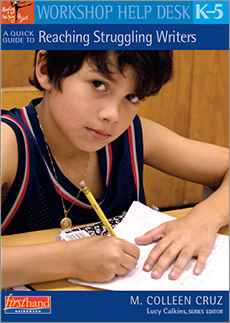Some of us are embarking on a science, reading, and writing study soon in our classrooms. We are ordering bugs, caterpillars, worms, and more in preparation for our students to observe animal life cycles. You may also be shopping for some books so kids can read about these insects during reading workshop. I just did some browsing myself and thought I would share the lists I made.
Happy Reading!
Books for Content Area Study of Insects:
Ladybug Books
Books found at Amazon.com and Other Online Booksellers:
Ladybugs: Red, Fiery, and Bright by Mia Posada
A Ladybug’s Life by J. Himmelman
Ladybugs by Claire Llewellyn
Ladybugs and Other Insects (Scholastic First Discovery) by Gallimard Jeunesse
A Ladybug Larva Grows Up (Scholastic News Non-fiction) by Katie Marsico
The Life Cycle of a Ladybug (Learning About Life Cycles) by Ruth Thompson
Ladybug (Life Cycles) by David M Schwartz
Books found at Book Source:
Are You A Ladybug by Judy Allen
Hungry Ladybugs by Judith Jango-Cohen
Crawl, Ladybug, Crawl! By Dana Meach Rau
Ladybug, Ladybug, What Are You Doing (Board Book) by Rourke, Eds.
Ladybugs by Margaret Hall
Ladybugs by Chery Coughlan
Mealworm to Beetle Books
Books found at Amazon.com and Other Online Booksellers:
From Mealworm to Beetle: Following the Life Cycle (Amazing Science) by Laura Purdie Salas
Mealworms (Watch it Grow) by Martha E. H. Rustad
Beetles (Welcome Books) by Edana Eckart
A Mealworm’s Life by John Himmelman
Young Naturalist’s Pop-Up Handbook: Beetles – Book #1 (Young Naturalist’s Handbook) by Robert Sabuda
Butterfly Books
Books found at Amazon.com and Other Online Booksellers:
Time for Kids: Butterflies! By Editors of Time for Kids
The Life Cycle of a Butterfly by Bobbie Kalman
Are You A Butterfly? By Judy Allen
The Life Cycles of Butterflies: From Egg to Maturity, A Visual Guide to 23 Common Garden Butterflies by Judy Burris
From Caterpillar to Butterfly by Deborah Heiligman
Monarch Butterfly by Gail Gibbons
Monarch Butterfly (Life Cycles) by David M. Schwartz
A Monarch Butterfly’s Life by John Himmelman
Ant Books
Books found at Amazon.com and Other Online Booksellers:
National Geographic Readers: Ants by Melissa Stewart
Are You An Ant? (Backyard Books) by Judy Allen
Inside an Ant Colony (Rookie Read-About Science) by Allan Fowler
The Life and Times of the Ant by Charles Micucci
Time for Kids: Ants! by Editors of Time for Kids
The Life Cycle of an Ant by Hadley Dyer (a Bobbie Kalman book)
Ant Cities (Let’s-Read-And-Find-Out Science 2) by Arthur Dorros







